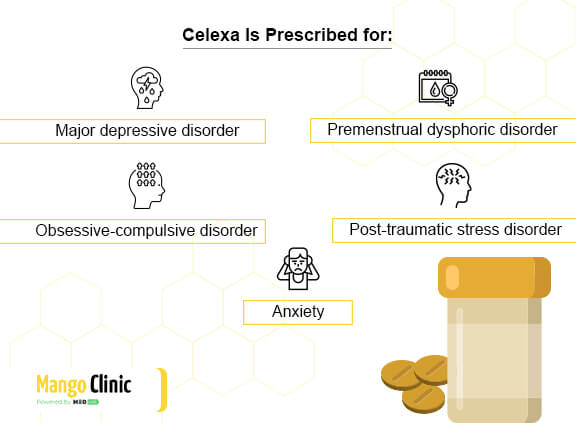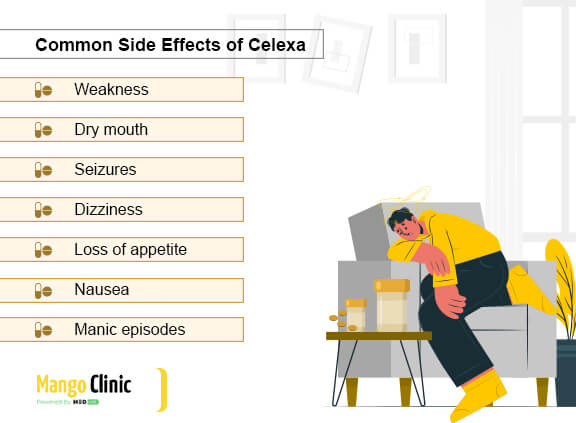How Celexa Works for Anxiety: Mechanism of Action, Side Effects

While the occasional anxiety, whether it is because of speaking before people or driving in traffic, is a normal part of life, an anxiety disorder is not. Instead of helping you improve your attention or motivating you to work harder, an anxiety disorder is crippling and intense, affecting your ability to lead a normal life.
Anxiety disorders are the most common emotional disorders in the US, with over 40 million adults having experienced them at one point in their lives. Fortunately, there are treatments for anxiety, including medications. One common drug used to treat this condition is Celexa, and this article aims to provide the most important information about it.
Ask our doctors about pharmacological anxiety treatment and get a prescription online.
What Is Celexa
Celexa is a branded version of Citalopram, which consists of two stereo-isomers: S-citalopram and R-citalopram. Stereo-isomers are compounds with the same chemical formula but different atomic arrangements.
The FDA approved the use of Celexa for Major Depressive Disorder in 1998. However, it is also used off-label to treat other conditions like anxiety, OCD, bipolar depression, premenstrual dysphoric disorder (PMDD), and post-traumatic stress disorder.
How Celexa Works
Celexa belongs to a group of drugs known as selective serotonin reuptake inhibitors (SSRIs). So, to better understand how this drug works, one should know more about serotonin. Serotonin is a neurotransmitter — a chemical messenger that sends signals between nerve cells. It plays several roles in regulating memory, thoughts, behavior, digestion, and mood. It is also regarded as a happy hormone.
The brain nerve cells naturally produce serotonin, releasing it in the spaces between them. The neurotransmitter then initiates a signal and nerve impulse or gets into a reuptake pump, where it is reabsorbed in the nerve cell that initially released it. This process ensures serotonin is recycled within the brain when needed, but as a downside, it reduces the amount of serotonin available to transmit messages between nerve cells.
Celexa, being an SSRI, blocks the reuptake pump making more serotonin available and thus allows the sending of more signals resulting in better regulation of the mood, sleep, thinking patterns, and other aspects. Celexa only targets serotonin in its action, preventing interference with other chemical transmitters.

How to Take Celexa for Anxiety
Celexa is available in the form of tablets or a liquid. It is a prescription medication meaning you can only get it with a doctor’s prescription. There is also a generic form of Celexa called Citalopram. The generic form costs US$0.74 while Celexa costs US$9.97, and both forms are similarly effective. Citalopram can be taken without or with food. You can also take it in the morning or evening, depending on how it makes you feel: alert or drowsy. Once patients settle on a specific time, they should stick to it daily.
Patients take the drug once daily, and the doctor usually starts them on a low Celexa dosage for anxiety to prevent citalopram side effects from being overwhelming, especially in the first week. The dosage of Citalopram 10 mg for anxiety can be then gradually increased from 20 mg up to 40 mg per day. The dose depends on how well the patient responds to treatment, the severity of symptoms, and how tolerable the drug is to the patient. For example, 20mg is the maximum Celexa dosage for people over 65.
If you miss a dose, doctors recommend taking it as soon as you remember it to prevent withdrawal symptoms and the risk of a sudden re-emergence of the anxiety attacks. However, if you remember it close to the time for the next dose, they recommend you skip the missed dose altogether and wait for the next dose since a double dose is dangerous.
Other warnings and guidelines when taking Celexa include:
- It can make you feel drowsy, so you should avoid operating heavy machinery or driving.
- You should also avoid consuming alcohol since a combination of alcohol and citalopram hugely impair your coordination, judgment, and motor skills.
Do you think your prescribed medication doesn’t work, or you experience side effects? Talk to a doctor to know if your treatment plan should be adjusted.
How Long Does It Take for Celexa to Work?
It varies on a case basis, but some symptoms like sleep and appetite problems will improve within the first two weeks. More significant symptoms will be observed by the eighth week. You may wonder how Citalopram makes you feel at first, and the answer is it is different per individual. Some patients may experience worsening symptoms in the first few weeks. Others may feel drowsy and even see an increase in anxiety temporarily.
It is unlikely that you will experience the positive effects of Celexa immediately. That’s because it takes time for the serotonin levels to build up in the brain, become balanced for mood regulation, and help control anxiety. It takes about four to six weeks for the drug to reach its full potential even before it, and patients will have noticed small improvements in their energy levels. If there is no improvement in your symptoms after six to eight weeks, you should talk to your doctor and consider switching to another medication.
How Effective Is Citalopram for Anxiety?
There is significant evidence that Celexa is effective in treating anxiety. A study showed that people who had 12 weeks of citalopram treatment for generalized anxiety disorder had a complete or partial improvement in their symptoms. Another study has shown that six to eight weeks of treatment have led to the positive clinical effect lasting up to 24 weeks.
Celexa Side Effects
Like most antidepressants, Celexa has several side effects. Some of these may occur early on with Celexa’s side effects in the first week, including nausea, drowsiness, and increased anxiety. The common side effects are:
- Weakness
- Dry mouth
- Loss of appetite
- Nausea
- Sleeping difficulties (drowsiness or insomnia)
- Sweating a lot
- Dizziness
- Anxiety
- Shaking
- Constipation
- Diarrhea
- Upper respiratory infections

There are also severe effects, including:
- Sexual dysfunction
- Hyponatremia
- Manic episodes
- Bleeding
- Seizures
- Serotonin syndrome
Severe side effects of Celexa are rare. One of the best benefits of the drug is its fewer side effects compared to other antidepressants.
Final Thoughts
Celexa is one of the most effective treatments for anxiety. Even though this is an off-label use, studies show it helps with the long-term treatment of anxiety. It has fewer side effects and is generally tolerable to most patients. However, patients should work closely with their doctors from prescription to the use of the medication as instructed. In case of a severe reaction or no improvement in symptoms, the doctor is best placed to guide you on when and how to make a switch to another medication.









